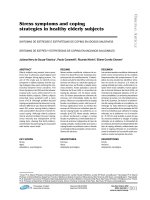Standard and Innovative Strategies in Cognitive Behavior Therapy Edited by Irismar Reis de Oliveira pdf
Bạn đang xem bản rút gọn của tài liệu. Xem và tải ngay bản đầy đủ của tài liệu tại đây (4.72 MB, 202 trang )
STANDARD
AND INNOVATIVE
STRATEGIES IN COGNITIVE
BEHAVIOR THERAPY
Edited by Irismar Reis de Oliveira
Standard and Innovative Strategies in Cognitive Behavior Therapy
Edited by Irismar Reis de Oliveira
Published by InTech
Janeza Trdine 9, 51000 Rijeka, Croatia
Copyright © 2012 InTech
All chapters are Open Access distributed under the Creative Commons Attribution 3.0
license, which allows users to download, copy and build upon published articles even for
commercial purposes, as long as the author and publisher are properly credited, which
ensures maximum dissemination and a wider impact of our publications. After this work
has been published by InTech, authors have the right to republish it, in whole or part, in
any publication of which they are the author, and to make other personal use of the
work. Any republication, referencing or personal use of the work must explicitly identify
the original source.
As for readers, this license allows users to download, copy and build upon published
chapters even for commercial purposes, as long as the author and publisher are properly
credited, which ensures maximum dissemination and a wider impact of our publications.
Notice
Statements and opinions expressed in the chapters are these of the individual contributors
and not necessarily those of the editors or publisher. No responsibility is accepted for the
accuracy of information contained in the published chapters. The publisher assumes no
responsibility for any damage or injury to persons or property arising out of the use of any
materials, instructions, methods or ideas contained in the book.
Publishing Process Manager Niksa Mandic
Technical Editor Teodora Smiljanic
Cover Designer InTech Design Team
First published March, 2012
Printed in Croatia
A free online edition of this book is available at www.intechopen.com
Additional hard copies can be obtained from
Standard and Innovative Strategies in Cognitive Behavior Therapy,
Edited by Irismar Reis de Oliveira
p. cm.
ISBN 978-953-51-0312-7
Contents
Preface IX
Part 1
Theoretical and Conceptual Foundations 1
Chapter 1
Assessing and Restructuring Dysfunctional Cognitions 3
Irismar Reis de Oliveira
Chapter 2
Modification of Core Beliefs in Cognitive Therapy
Amy Wenzel
Chapter 3
Use of the Trial-Based Thought Record
to Change Negative Core Beliefs 35
Irismar Reis de Oliveira
Part 2
17
Cognitive-Behavioral Therapy 61
Chapter 4
Cognitive-Behavioral Therapy for Depression 63
Neander Abreu, Vania Bitencourt Powell and Donna Sudak
Chapter 5
Cognitive-Behavioral Therapy
for the Bipolar Disorder Patients 77
Mario Francisco P. Juruena
Chapter 6
Cognitive-Behavioral Therapy
of Obsessive-Compulsive Disorder 99
Aristides V. Cordioli and Analise Vivan
Chapter 7
Cognitive Behavioral Therapy
for Somatoform Disorders 117
Robert L. Woolfolk and Lesley A. Allen
Chapter 8
A Proposed Learning Model
of Body Dysmorphic Disorder 145
Fugen Neziroglu and Lauren M. Mancusi
VI
Contents
Chapter 9
Chapter 10
Cognitive-Behavior Therapy for Substance Abuse 157
Bernard P. Rangé and Ana Carolina Robbe Mathias
Internet Addiction and
Its Cognitive Behavioral Therapy 171
Ömer Şenormancı, Ramazan Konkan and Mehmet Zihni Sungur
Preface
To my knowledge, this is the first free-access cognitive-behavioral therapy (CBT) book
available to anyone who wishes to download it. Although CBT is undoubtedly the
fastest growing and the best empirically validated psychotherapeutic approach,
unfortunately, access to CBT may be limited for people living in under-developed
countries, or for those who have limited economical resources. The goal of this project
made possible by InTech is, at least in part, to close this gap, and to bring CBT to as
many mental health professionals as possible.
It is mandatory that a CBT book of this kind recognize and demonstrate gratitude to
the pioneer work of Aaron T. Beck, whose remarkable life is a model and inspiration
for those of us who have had the privilege of knowing him personally. The father of
cognitive therapy, now in his 10th decade of an extremely rich and productive life,
continues to make significant contributions to psychotherapy.
The development of CBT reflects Beck’s life, and his contributions are considered
among the greatest in the history of psychology and psychiatry. Several seminal
concepts such as “automatic thoughts” which describe the thoughts popping into
one’s mind during the day; the “cognitive triad” which conveys the negative beliefs
depressed people hold about themselves, the world and the future; and a new
“schema” theory which describes the interactions between cognition and emotion –
were coined in the 1960s. Beck’s ideas were further refined in the 1970s, with other
important concepts such as “collaborative empiricism” – where the therapist and the
patient work as a team by means of an interviewing style called “Socratic questioning”
(Padesky, 2004).
Since the 1970s, especially after the publication of the book Cognitive Therapy and the
Emotional Disorders (Beck, 1976), in which he described a theory of emotional disorders
and the new psychotherapeutic approach with emphasis in depression, there has been
a veritable “cognitive revolution”, and this approach expanded to a range of problems
and disorders, encompassing every anxiety disorder, psychoses, personality disorders,
and numerous other conditions such as chronic pain, addictions and marital problems.
Not only did Beck continue to refine cognitive therapy, but his followers also
developed new protocols for almost any existing psychological or psychiatric disorder.
I wholeheartedly agree with Leahy (2004) when he writes: “Quite infrequently in the
X
Preface
field of psychology, someone comes along with a vision that changes everything. Tim
Beck has given us this vision.” It is my hope that this book will reflect a glimpse of
Beck’s enormous legacy to mankind.
The first three chapters of this book, comprising Section 1, introduce basic and
conceptual aspects of CBT. In the opening chapter, I inform on how to assess and
restructure cognitions, focusing on automatic thoughts and underlying assumptions. I
also describe a new decision-making technique, the consensual role-play, designed to
help patients understand and deal with ambivalence.
Amy Wenzel contributes an excellent review (Chapter 2), one of the best I’ve ever read
on this topic, providing the main techniques developed to modify core beliefs in
cognitive therapy.
In Chapter 3, I expand the previous chapter by introducing a novel approach, the trialbased thought record (TBTR), especially designed to restructure core beliefs. The
transcription of a dialogue showing its implementation makes the presentation of this
technique much clearer and more practical.
Section 2 of this book covers the cognitive therapy of some of the main psychiatric
disorders. Abreu, Powell and Sudak (Chapter 4) provide a review of the recent
developments of the CBT for depression; and Juruena (Chapter 5) introduces a review
of the evidence of the cognitive-behavioral treatment for the bipolar disorder patients.
In Chapter 6, Cordioli and Vivan comprehensively review the CBT of obsessivecompulsive disorder. Woolfolk and Allen (Chapter 7) bring to our attention the latest
advances in the CBT for somatoform disorders, while Neziroglu and Mancusi
(Chapter 8) expand this topic by proposing a new learning model of body dysmorphic
disorder.
Finally, two chapters on addiction close this book. Şenormanci, Konkan, and Sungur
(Chapter 9) provide a thorough review of the recent phenomenon of Internet addiction
and its cognitive-behavioral treatment; and Rangé and Mathias (Chapter 10) conclude
with the CBT for substance abuse.
A book like this would not be possible without careful support. So, I gratefully thank
the organizational skills of Mr. Niksa Mandic, publishing process manager, who was
present and attentive along all the steps of this project.
Irismar Reis de Oliveira
Department of Neurosciences and Mental Health,
Federal University of Bahia,
Brazil
Preface
References
Beck, A (1976) Cognitive Therapy and the Emotional Disorders. International
Universities Press, New York.
Leahy RL (2004) Preface. In: Leahy R.L. (Ed.) Contemporary cognitive therapy: theory,
research, and practice. Guilford, New York.
Padesky CA (2004) Aaron T. Beck: mind, man, and mentor. In: Leahy R.L. (ed.)
Contemporary cognitive therapy: theory, research, and practice. Guilford
Press, New York.
XI
Part 1
Theoretical and Conceptual Foundations
1
Assessing and Restructuring
Dysfunctional Cognitions
Irismar Reis de Oliveira
Department of Neurosciences and Mental Health,
Federal University of Bahia,
Brazil
1. Introduction
Cognition impacts clinically relevant aspects of day-to-day function, such as emotion,
behavior, and interpersonal relationships, and involves structures necessary to support
information processing. The exchange of interpersonal information in therapy typically
comprises emotional states, behavioral symptoms, expectations for improvement, and
experiences and meanings attached to experiences, that may occur according to implicit
(non-conscious) and explicit (conscious) levels of awareness on the part of both the client
and the therapist (Alford & Beck, 1997).
This chapter has two learning objectives: 1) help the patient to identify and change
cognitions in the first and most superficial level of information processing – comprising
negative automatic thoughts (ATs), and expressed as consistent errors in patients’ thinking;
2) help the patient to identify and change cognitions in the second and intermediate level of
information processing – comprising the underlying assumptions (UAs) or conditional
beliefs.
Two other chapters in this book are focused on identifying and restructuring negative core
beliefs (CBs) and schemas, conceptualized as the third and deeper level of information
processing (Wenzel, 2012; de-Oliveira, 2012).
2. Cognitive model
Cognitions may be assessed on at least three levels (Fig. 1). On a more superficial level of
information processing, cognitions are known as ATs. Hollon & Kendall (1980) developed
the Automatic Thoughts Questionnaire (ATQ-30), a 30-item questionnaire conceived to
measure the frequency of occurrence of ATs, typically expressed as negative self-statements,
and associated with depression. In the intermediate level of information processing,
cognitions are usually called UAs or conditional beliefs. Weissman & Beck (1978) developed
the Dysfunctional Attitude Scale to assess negative attitudes of depressed patients towards
self, the outside world, and the future. Finally, in the deepest level of information
processing, cognitions are known as CBs or schemas. Beck et al. (2001) proposed the
Personality Beliefs Questionnaire, and Young and Brown (1994) developed the Young
Schema Questionnaire to assess these beliefs.
4
Standard and Innovative Strategies in Cognitive Behavior Therapy
It is largely recognized that cognitions and their relation to emotional and behavioral
responses are complex phenomena. Fig. 1 illustrates the highly complex interactions
between different elements of the cognitive model and the reciprocal influences of each
element over the others.
Fig. 1. Complex interactions between cognitions and responses to cognitions. (Copyright:
Irismar Reis de Oliveira; )
The full arrows seen in Fig. 1 represent more direct effects and the interrupted arrows
represent possible indirect effects in the chain of elements triggered by a situation. This is
important, for instance, when the therapist explains why different situations provoke
different reactions (interrupted arrow between situation and AT) in different people or in the
same people in different situations. Considering this complex model, a diagram that could
make these interactions more easily understandable for the client during the therapeutic
process would be particularly useful.
3. Case conceptualization
Case conceptualization is a key element in cognitive-behavioral therapy (CBT), and may be
defined as a description of a patient’s presenting problems that uses theory to make
explanatory inferences about causes and maintaining factors, as well as to inform interventions
(Kuyken et al, 2005). However, sharing its components with patients may be a complex and
difficult task. As a highly individualized work, it should be collaboratively built with the
client, while educating him/her about the cognitive model. While there are numerous case
conceptualization diagrams proposed by different authors for different disorders and
problems, Judith Beck’s diagram is the most well known and used (J.S. Beck, 1995).
I designed a conceptualization diagram (shown in Figs. 2 and 3) to make the cognitive
model easier to be understood by the client during therapy. It was developed for use in
5
Assessing and Restructuring Dysfunctional Cognitions
Trial-Based Cognitive Therapy (de-Oliveira, 2011), but not limited to this approach, as its
components are the same ones found in conventional CBT.
TBCT Conceptualiza on Diagram (Phase 1)
Situation
Automatic Thought
Emotional reaction
Behavioral and/or
physiological response
1st level
Underlying assump ons/rules:
2nd level
Compensatory strategies/safety behaviors:
Modula on by underlying
assump ons
Relevant childhood data for:
1) nega ve core belief
3rd level
2) Posi ve core belief
Ac vated nega ve
core belief
Inactive positive
core belief
Fig. 2. TBCT conceptualization diagram showing an activated negative core belief.
(Copyright: Irismar Reis de Oliveira; )
In the first level of information processing shown in Fig. 2, a situation appraised by the
patient as dangerous (AT box) would elicit anxiety (emotional reaction box) that could
paralyze him/her (behavioral and physiological responses box). Arrows returning to the
emotional reaction, ATs and situation boxes inform the patient about the circular nature of
these interactions (confirmatory bias) that prevent him/her from reappraising the situation
and consequently changing the erroneous perceptions it triggered.
This diagram might also be useful to make the patient understand that behaviors used in
specific situations that elicit less anxiety and consequently yield a sense of immediate relief
(e.g., avoidance) may progressively become a safety behavior (arrow directed from the
behavioral and physiological responses box from the first to the second level on the right side of
the picture). This means that perceptions in the first level may progressively become UAs or
rules that are now maintained by the compensatory strategies and safety behaviors
(confirmatory bias) seen in the second level. Safety behaviors then assume a modulatory
function. Under the influence of the UAs that support such behaviors, first level appraisals
(ATs) may be repeatedly confirmed. Also, third level (unconditional) CBs may be activated
if UAs are challenged (for example, during exposure), or inactivated if UAs are not
challenged (for example, by avoidance).
6
Standard and Innovative Strategies in Cognitive Behavior Therapy
Having sufficient practice in identifying and changing ATs by replacing them with more
functional alternative appraisals, the patient may progressively notice changes in the other
levels, for instance, activation of positive CBs. However, restructuring negative CBs (see
chapters 2 and 3 in this book.) is considered an important step for more durable results in
therapy. Fig. 3 graphically illustrates such changes.
4. Dysfunctional ATs and cognitive distortions
ATs are rapid, evaluative thoughts that do not arise from deliberation or reasoning; as a
result, the person is likely to accept them as true, without analysis (J.S. Beck, 1995). It is not
uncommon for ATs to be distorted, and result in dysfunctional emotional reactions and
behaviors that, in turn, produce more cognitive errors that maintain the vicious circle (level
1 of Fig. 1).
Fig. 3. TBCT conceptualization diagram showing an activated positive core belief.
(Copyright: Irismar Reis de Oliveira; ).
Table 1 includes 15 known cognitive distortions, their definitions and examples (Burns,
1980; Beck, 1976; J.S. Beck 1995; Dryden & Ellis, 2001; Leahy, 2003). Teaching the patient to
identify cognitive distortions is an important step to restructure such dysfunctional ATs.
This may be done by means of the Intrapersonal Thought Record (IntraTR) described below.
It is illustrated with the case of a panic disorder patient.
Assessing and Restructuring Dysfunctional Cognitions
Cognitive distortions
1 Dichotomous thinking
(also called all-ornothing, black and
white, or polarized
thinking)
2 Fortune telling (also
called catastrophizing)
3 Discounting or
disqualifying the
positive
4 Emotional reasoning
5 Labeling
Definitions
I view a situation, a person or
an event only in all-or-nothing
terms, fitting them into only
two extreme categories instead
of on a continuum.
I predict the future in
negative terms and believe
that what will happen will be
so awful that I will not be
able to stand it
I disqualify and discount
positive experiences or events
insisting that they do not
count.”
I believe my emotions reflect
reality and let them guide my
attitudes and judgments.
I put a fixed, global label,
usually negative, on myself or
others.
6 Magnification/minimiz I evaluate myself, others, and
ation
situations magnifying the
negatives and/or minimizing
the positives.
7 Selective abstraction
I pay attention to one or a few
(also called mental
details and fail to see the
filter and tunnel vision) whole picture
8 Mind reading
9 Overgeneralization
I believe that I know the
thoughts or intentions of others
(or that they know my
thoughts or intentions) without
having sufficient evidence.
I take isolated cases and
generalize them widely by
means of words such as
“always”, “never”,
“everyone”, etc.
7
Examples
“I made a mistake, therefore
I’m a failure”. “I ate more than
I planned, so I blew my diet
completely”
My example:
“I will fail and this will be
unbearable.” “I’ll be so upset
that I won’t be able to
concentrate for the exam.”
My example:
“I passed the exam, but I was
just lucky.” “Going to college is
not a big deal, anyone can do it.”
My example:
“I feel she loves me, so it must
be true.” “I am terrified of
airplanes, so flying must be
dangerous.”
My example:
“I’m a loser.” “He’s a rotten
person.” “She’s a complete
jerk.”
My example:
“I got a B. This proves how
inferior I am.” “I got an A. It
doesn’t mean I’m smart.”
My example:
“My boss said he liked my
presentation, but since he
corrected a slide, I know he did
not mean it.” “Even though the
group said my work was good,
one person pointed out an error
so I know I will be fired.”
My example:
“He’s thinking that I failed”.
“She thought I didn’t know the
project.” “He knows I do not
like to be touched this way.”
My example:
“Every time I have a day off
from work, it rains.” “You only
pay attention to me when you
want sex”.
My example:
8
10 Personalizing
Standard and Innovative Strategies in Cognitive Behavior Therapy
I assume that others’
behaviors and external events
concern (or are directed to)
myself without considering
other plausible explanations.
11 Should statements (also I tell myself that events,
“musts”, “oughts”,
people’s behaviors, and my
“have tos”)
own attitudes “should” be the
way I expected them to be and
not as they really are.
12 Jumping to conclusions I draw conclusions (negative
or positive) from little or no
confirmatory evidence.
“I felt disrespected because
the cashier did not say thank
you to me” (not considering
that the cashier did not say
thank you to anyone).
“My husband left me because I
was a bad wife”(not
considering that she was his
fourth wife).
My example:
“I should have been a better
mother”. “He should have
married Ann instead of Mary”.
“I shouldn’t have made so
many mistakes.”
My example:
“As soon as I saw him I knew
he had bad intentions.”
“He was looking at me, so I
concluded immediately he
thought I was responsible for
the accident”.
My example:
‘My parents are the ones to
blame for my unhappiness.”
“It is my fault that my son
married a selfish and uncaring
person.”
My example:
13 Blaming (others or
oneself)
I direct my attention to others
as sources of my negative
feelings and experiences,
failing to consider my own
responsibility; or, conversely,
I take responsibility for
others’ behaviors and
attitudes.
14 What if?
I keep asking myself questions “What if my car crashes?”
such as “what if something
“What if I have a heart
happens?”
attack?”“What if my husband
leaves me?”
My example:
I compare myself with others “My father always preferred
who seem to do better than I my elder brother because he
do and place myself in a
is much smarter than I am.”
disadvantageous position.
“I am a failure because she
is more successful than I am.”
My example:
15 Unfair comparisons
Table 1. Cognitive distortions, definitions and examples. (Copyright: Irismar Reis de
Oliveira; ).
Assessing and Restructuring Dysfunctional Cognitions
9
4.1 Intrapersonal thought record
A premise of CBT is that exaggerated or biased cognitions often maintain or exacerbate
stressful states such as depression, anxiety, and anger (Leahy, 2003).
Beck et al. (1979) developed the Dysfunctional Thought Record (DTR) as a worksheet to help
patients respond to ATs more effectively, thereby modifying negative mood states. This
approach is useful for many patients who use the DTR consistently. However, for some
patients, the alternative thoughts generated through the DTR and intended to be perceived
as adaptive and rational may still lack credibility (de-Oliveira, 2008). To address this issue,
Greenberger & Padesky (1995) expanded the original 5-column DTR designed by Beck et al.
(1979) to seven columns. The two additional columns were evidence columns, allowing the
patient to include evidence that does and does not support the ATs, enabling the patient to
develop more balanced thoughts, and thus improve associated emotional reactions and
behaviors.
I devised the IntraTR in order to make the restructuring of ATs easier for the patient, and to
allow him/her to connect the ATs to the conceptualization diagram shown in Figs. 2 and 3.
The following case vignette of a panic disorder patient illustrates how the IntraTR and the
conceptualization diagram can be used together in order to restructure dysfunctional ATs
(de-Oliveira, 2011b).
4.1.1 Case illustration
Sean, aged 35, had a 10-year history of frequent panic attacks with increasingly severe
agoraphobia. SSRIs and benzodiazepines reduced his panic attacks’ intensity and
frequency, but his agoraphobia worsened, and for 3 years Sean had rarely left home alone.
His fear of travelling even when accompanied limited his professional and personal life
(his fiancée lived 200 miles away). Sean had 10 treatment sessions over 3 months. In
session 1, he learned that fear and anxiety were normal, was introduced to the cognitive
model (level 1 of the conceptualization diagram), and did interoceptive exposure by
hyperventilating.
Sean was asked to learn about the cognitive distortions as homework. He received from
the therapist a sheet (Table 1) containing names (column 1), definitions (column 2) and
examples (column 3) of cognitive distortions. Also, Sean was asked to write down his own
examples of cognitive distortions during the week in the space identified as “My
example” in column 3 of Table 1. Identifying his own examples prepared Sean to be
introduced to the Cognitive Distortions Questionnaire (CD-Quest) and the IntraTR, to be
explored in session 2. In session 2, Sean completed the CD-Quest and an IntraTR in order
to restructure his catastrophic ATs (e.g. “I’ll lose control and go mad”). In session 3, Sean
filled in 2 more IntraTRs. The CD-Quest was filled in weekly during the whole therapy
process.
Fig. 4 illustrates Sean’s conceptualization diagram, and Fig. 5 is the IntraTR filled in by
Sean in session 2. In a situation in which he was preparing himself to go to work, he
noticed his heart racing (situation box). Sean had the AT “I will have an attack again” (AT
box), and felt anxious (emotional reaction box). Consequently, Sean decided not to go to
10
Standard and Innovative Strategies in Cognitive Behavior Therapy
work (behavioral and physiological response box). The therapist asked Sean to examine
the cognitive distortions sheet (Table 1) in order to identify possible thinking errors and
fill in item 1 of the IntraTR (Fig. 5). Sean came up with fortune telling and catastrophizing.
Items 2 and 3 of the IntraTR helped Sean to uncover the evidence supporting and not
supporting the AT. Sean was then asked to find out any advantages of behaving
according to the AT (item 4). The answer was “No, because it makes me feel vulnerable.”
The therapist asked Sean how he could test the credibility of the AT (item 5) and the
answer was: “Expose myself more.” Sean was then stimulated to bring an alternative,
more adaptive, hypothesis to replace the AT, one which could better explain the situation.
Sean said: “This is just my heart racing. My amygdala is again hyperactive,” was
considered a more plausible and credible explanation, which he believed 70%. His anxiety
fell to 40%, and he became able to go to work. After this work, Sean believed the AT (item
7) only 30%, and felt much better (item 8).*
Fig. 4. Sean’s TBCT conceptualization diagram filled in at the beginning of treatment.
(Copyright: Irismar Reis de Oliveira; ).
*
Sean’s complete treatment may be assessed in the Common Language for Psychotherapy (CLP)
procedures website (Trial-based cognitive therapy:
).
Assessing and Restructuring Dysfunctional Cognitions
11
Fig. 5. One of Sean’s IntraTRs filled in at the beginning of treatment (Copyright: Irismar Reis
de Oliveira; ).
4.2 CD-Quest
The Cognitive Distortions Questionnaire (CD-Quest) was developed as an operational
instrument, to be routinely used by patients to facilitate perceptions of the link between
cognitive errors and their consequent emotional states, as well as dysfunctional behaviors
(de-Oliveira et al. 2011). Also, it was designed to help therapists quantitatively assess and
follow the clinical evolution of patients by means of its scores. It comprises 15 items that
assess known cognitive distortions in two dimensions. The scores may range from 0 to 75.
In the first study conducted by our group (de-Oliveira et al. 2011), the initial psychometric
properties of the CD-Quest in its Brazilian Portuguese version in a sample of university
students were assessed. Medical and psychology students (n = 184; age = 21.8 ± 3.37) were
evaluated using the following instruments: CD-Quest, Beck Depression Inventory (BDI),
Beck Anxiety Inventory (BAI), and the Automatic Thoughts Questionnaire (ATQ). These
self-report instruments were applied collectively in classrooms. The CD-Quest showed good
internal consistency (0.83 - 0.86) and concurrent validity with BDI (0.65), BAI (0.51), and
ATQ (0.65). Furthermore, it was able to discriminate between groups possessing depressive
(BDI ≥ 12) and anxious (BAI ≥ 11) indicators from those not possessing such indicators
(p < .001). An exploratory factor analysis by means of principal components analysis with
varimax rotation showed the presence of four factors that together explained 56.6% of data
12
Standard and Innovative Strategies in Cognitive Behavior Therapy
variance. The factors consisted of the following types of cognitive distortions: (a) Factor I:
dichotomous thinking, selective abstraction, personalizing, should statements, what if…,
unfair comparisons; (b) Factor II: emotional reasoning, labeling, mind reading, jumping to
conclusions; (c) Factor III: fortune telling, discounting positives, magnification /
minimization; and (d) Factor IV: overgeneralizing, blaming. It was concluded that the CDQuest was characterized by good psychometric properties, justifying the need for larger
studies designed to determine its predictive validity, expand its construct validity, and
measure the degree to which it is a useful measure of change achieved by patients in
cognitive behavioral therapy.
5. UAs and safety behaviors
Behavioral experiments are amongst the most powerful strategies for bringing about change
in CBT (Bennett-Levy et al. 2004), and provide a meeting ground for communication
between knowledge derived from the rational mind and emotional mind (Padesky, 2004).
Behavioral experiments are especially used to change UAs. These cognitions are expressed
as conditional beliefs such as “If I go out alone, then I will have a heart attack and may die.”
Consequently, he or she usually avoids feared situations. In session 4 (see case illustration
above), Sean was helped to go over his conceptualization diagram (Fig. 4), and understand
that exposing himself to feared situations (for example, going out alone to work) was
necessary to overcome unpleasant emotions and behaviors. Consensual Role-Play (CRP), a
7-step decision-making method, was proposed by the therapist to facilitate Sean’s
behavioral experiments (e.g. go out alone), and to challenge his safety behaviors (e.g.
avoidance).
Fig. 6 shows how therapist and patients can increase the chance of the patient confronting
situations made difficult by UAs and repeatedly reinforced safety behaviors. For example,
Sean was encouraged to list advantages and disadvantages of coming alone to the therapy
session (step 1). Then, he was helped by the therapist to confront the dissonance between
“reason” and “emotion” (Padesky, 2004). For instance, Sean gave a 70% weight to
advantages of going out alone (versus 30% for disadvantages) according to reason, but 90%
weight to disadvantages of going out alone (versus 10% for advantages) according to
emotion (step 2). By means of the empty chair approach (Greenberg, 2011), the therapist
asked Sean to reach a consensus between “reason” and “emotion” in a 15-minute dialogue
(step 3). After this step, the therapist asked Sean to assess the weight of advantages vs.
disadvantages, coming to a consensus between rational and emotional perspectives. Sean
was able to give an 80% weight for the advantages of going out alone vs. 20% weight for the
disadvantages of going out alone (step 4). Next, after a debriefing of what Sean learned from
this analysis (step 5), the therapist asked him if he was ready to make a decision: the answer
was “yes,” and Sean decided that he was able to try going out alone as an experiment (step
6). In order to increase the chances of success, the therapist helped Sean organize an action
plan (Greenberger & Padesky, 1995), so that not only could Sean organize what to do, but he
could also anticipate obstacles and find their solutions (step 7).
Another strategy that may help patients to increase the chances of doing behavioral
experiments is providing a hierarchy of symptoms to which they are supposed to be
exposed in order to obtain symptom remission. After collecting a detailed list of symptoms
Assessing and Restructuring Dysfunctional Cognitions
13
(e.g., OCD or social phobia symptoms), in which the patient scores each one according to the
hierarchy shown in Fig. 7, the therapist informs him/her that there will be no focus on blue
symptoms, but he/she will choose 2 or 3 green symptoms to practice exposure as
homework during the week. In general, the therapist uses CRP to help patients accept to
expose themselves to yellow symptoms, usually during therapy sessions. These are
symptoms patients resist to confront when they are alone, and CRP seems to make this
challenge acceptable, at least in the therapist's presence. The therapist explains to the patient
that he/she will NEVER need to challenge red symptoms. This information tends to make
the patient more willing to comply with the technique because there is no pressure to
confront the most anxiety provoking items. Therapist and patient keep track of individual
and global symptom scores weekly. The patients notice that the scores continue to decrease
(both those which he/she exposed him/herself to and those which he/she did not expose
him/herself to). Patients are very surprised to realize that even red symptoms scores
decrease, making exposure acceptable because they gradually become yellow or green.
Showing the patient a global score chart helps him/her track weekly progress and notice
scores change. The symptoms list to be filled out weekly is presented to the patient in a way
that past scores are hidden, so that he/she will not be influenced by past symptoms scores.
Fig. 6. Consensual role-play (CRP) as a decision-making approach (Copyright: Irismar Reis
de Oliveira; ).









